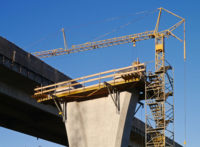Residential building, at $214.3 billion (annual rate), grew 3% in June. Multifamily housing rebounded 22%, as it continues to show an up-and-down pattern around what is still a rising trend. The latest month included four noteworthy multifamily projects—two apartment buildings in Jersey City NJ valued at $269 million and $200 million respectively, $160 million for the condominium portion of a $230 million condo-hotel in Surfside, Fla., and $120 million for the condominium portion of a $195-million condo-hotel addition in New York City.
Single-family housing in June slipped 2% from May, continuing the essentially flat pattern that emerged toward the end of 2013 and has carried over into 2014. Murray noted, “The cost of financing stayed low in June, as the 30-year-fixed mortgage rate finished the month at 4.1%, but strict bank-lending standards continue to make it hard for first-time homebuyers to enter the market, at a time when investor demand for single-family homes is waning.”
At the six-month mark of 2014, residential building in dollar terms was up 4% from a year ago, a much smaller gain than the annual increases that were reported in 2012 (up 31%) and 2013 (up 26%). Single-family housing year-to-date was up only 1%, which reflected this pattern by the five major regions of the U.S.—the Northeast, up 6%; the South Central, up 4%; the South Atlantic, unchanged; and the West and Midwest, each down 2%.
Multifamily housing advanced 16% year-to-date, not as large as the 24% hike for the full year 2013, but still in the double-digit range. The top five multifamily markets ranked by the dollar amount of new construction starts in the first half of 2014 were New York City, Washington, D.C., Los Angeles, Miami and Boston. Multifamily construction markets ranked six through 10 were San Francisco, Dallas-Ft. Worth, Denver, Philadelphia and Houston.
Nonbuilding Construction
Nonbuilding construction in June increased 2% to $120.5 billion (annual rate). New electric utility starts were up 26% for the month, strengthening from a weak May, although still in line with the downward trend for this project type that’s been underway over the past year.
Large electric-utility projects that reached the construction start stage in June included a $700-million natural-gas-fired generation plant in Iowa, a $225-million wind farm in Oklahoma and a $120-million transmission line project in Virginia. The public-works sector overall weakened 1% in June, due to declines for two categories. Bridge construction fell 12% relative to May, which had been lifted by substantial bridge projects in New York and Kentucky, while miscellaneous public works plunged 28%.
In contrast, new highway construction starts in June improved 6%, while the environmental public-works categories showed these gains—river/harbor development, up 14%; sewers, up 15%; and water-supply systems, up 23%. The water-supply category was helped in particular by the June start of a $108-million water treatment plant in San Antonio.
For the first six months of 2014, nonbuilding construction dropped 14% compared to last year. New electric-utility starts were down 23%, as the pullback from the 2012 record high continues. Public-works construction overall fell 12% year-to-date, with reduced activity across most of the project types.
On the transportation side, highways and bridges posted year-to-date declines of 17% and 12%, respectively. The retreat for bridge construction will get steeper as 2014 proceeds, given the comparison to the second half of 2013 that included the start of several massive bridge projects, including the Tappan Zee Bridge replacement project in New York.
The top five states for highway and bridge construction during the first half of 2014 were Texas, California, Pennsylvania, Illinois and New York. States ranking six through 10 in the January-June period were North Carolina, Virginia, Florida, Ohio and New Jersey.
The miscellaneous public works category in the first half of 2014 dropped 11%, given a weak amount of new pipeline projects that reached the construction start stage. The environmental public-works categories year-to-date were mixed, including a steep 17% slide for water supply systems, a modest 1% dip for sewer construction and a 3% gain for river/harbor development.
Murray added, “The public-works sector is facing several near-term negatives, including the need for Congress to shore up the Highway Trust Fund this summer and come up with a replacement for the MAP-21 legislation set to expire at the end of September. A successor bill to MAP-21 that is more than just a status quo extension will probably have to wait until after the November elections.”
The 1% gain for total construction starts at the U.S. level during the first six months of 2014 came from a varied pattern by geography. Growth relative to the same period a year ago was reported in the South Central, up 9%; and the Northeast, up 5%.
The South Central’s increase reflected widespread construction strength in Texas as well as the boost coming from the start of several massive chemical and refinery plants in that region.
The increase in the Northeast reflected the brisk pace being reported for new multifamily construction. The West on a year-to-date basis was unchanged from 2013 while weaker activity was reported in the Midwest, down 2%; and the South Atlantic, down 5%.


Post a comment to this article
Report Abusive Comment